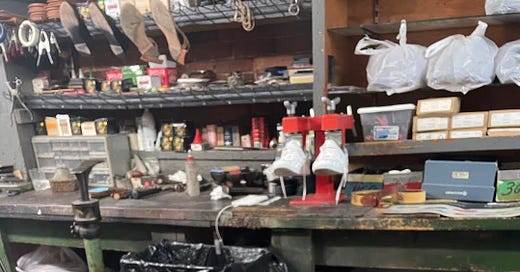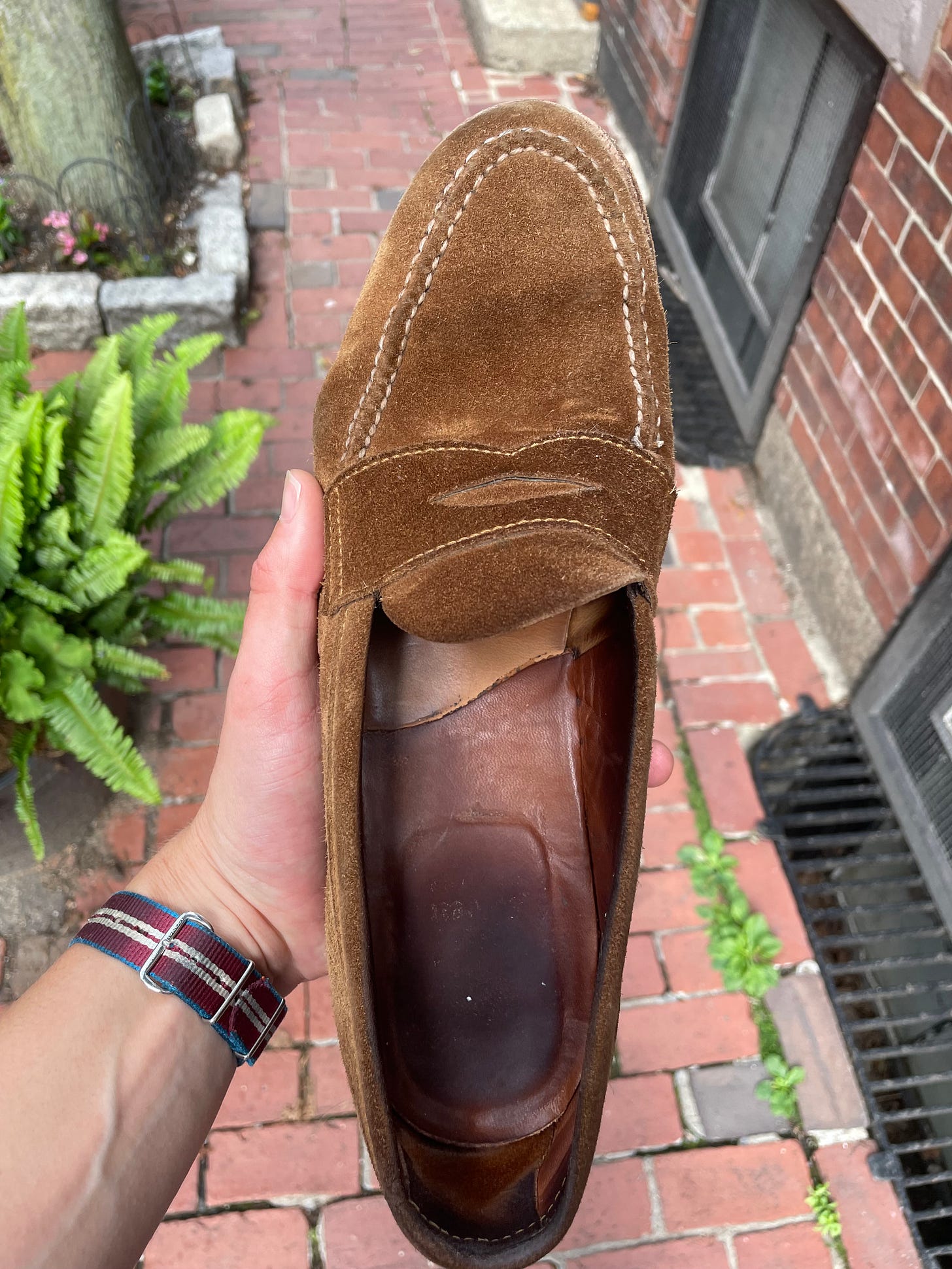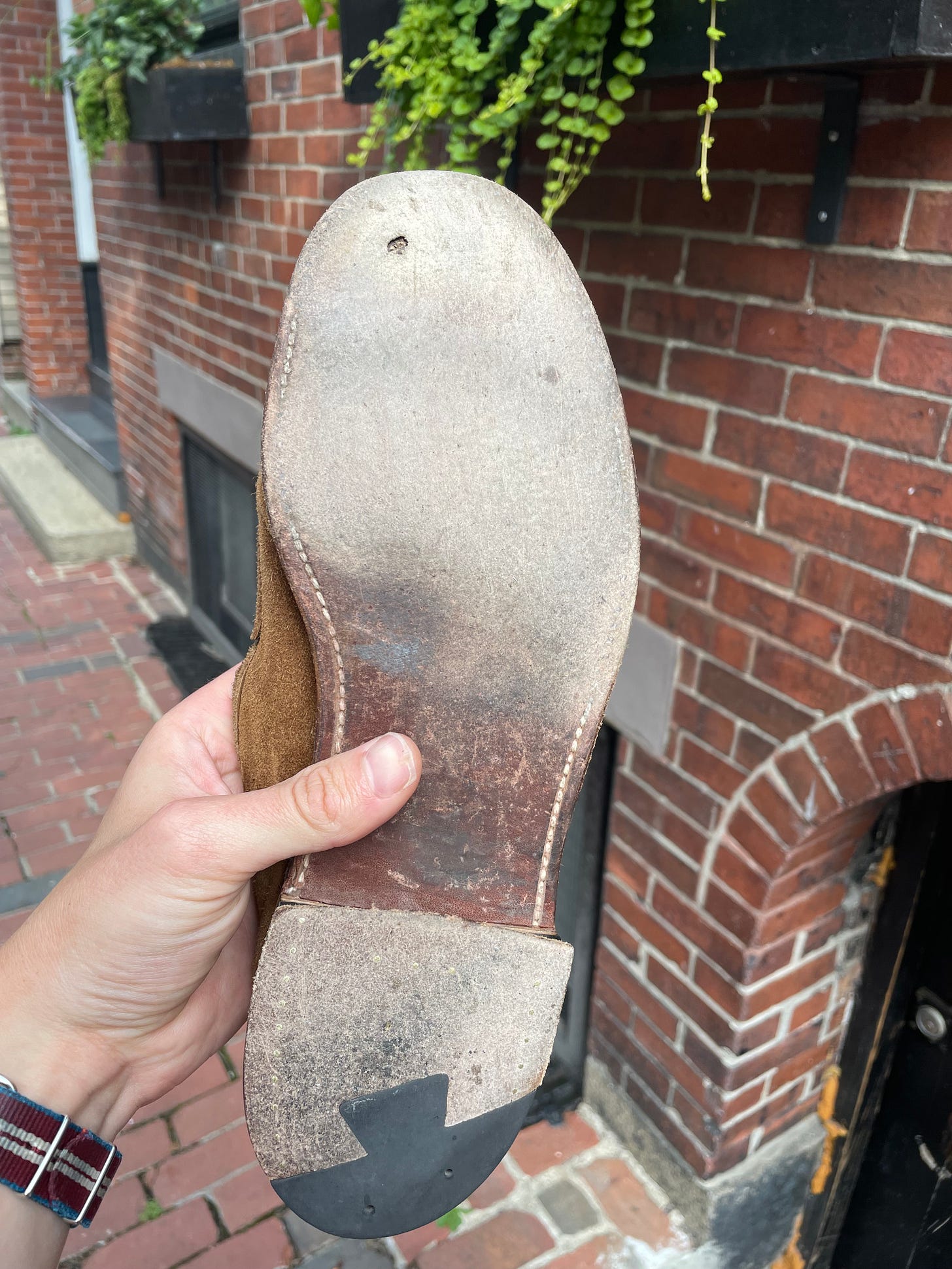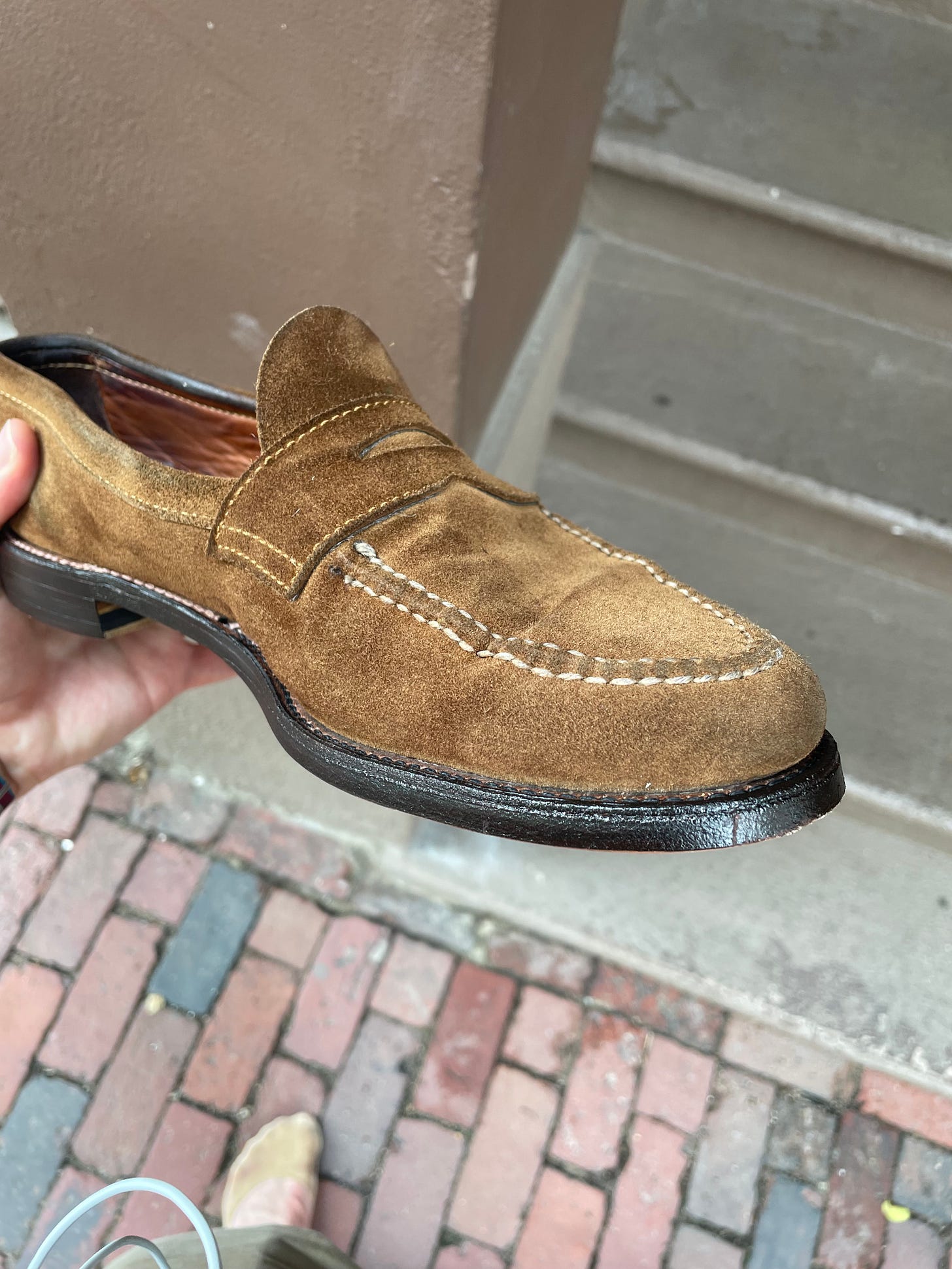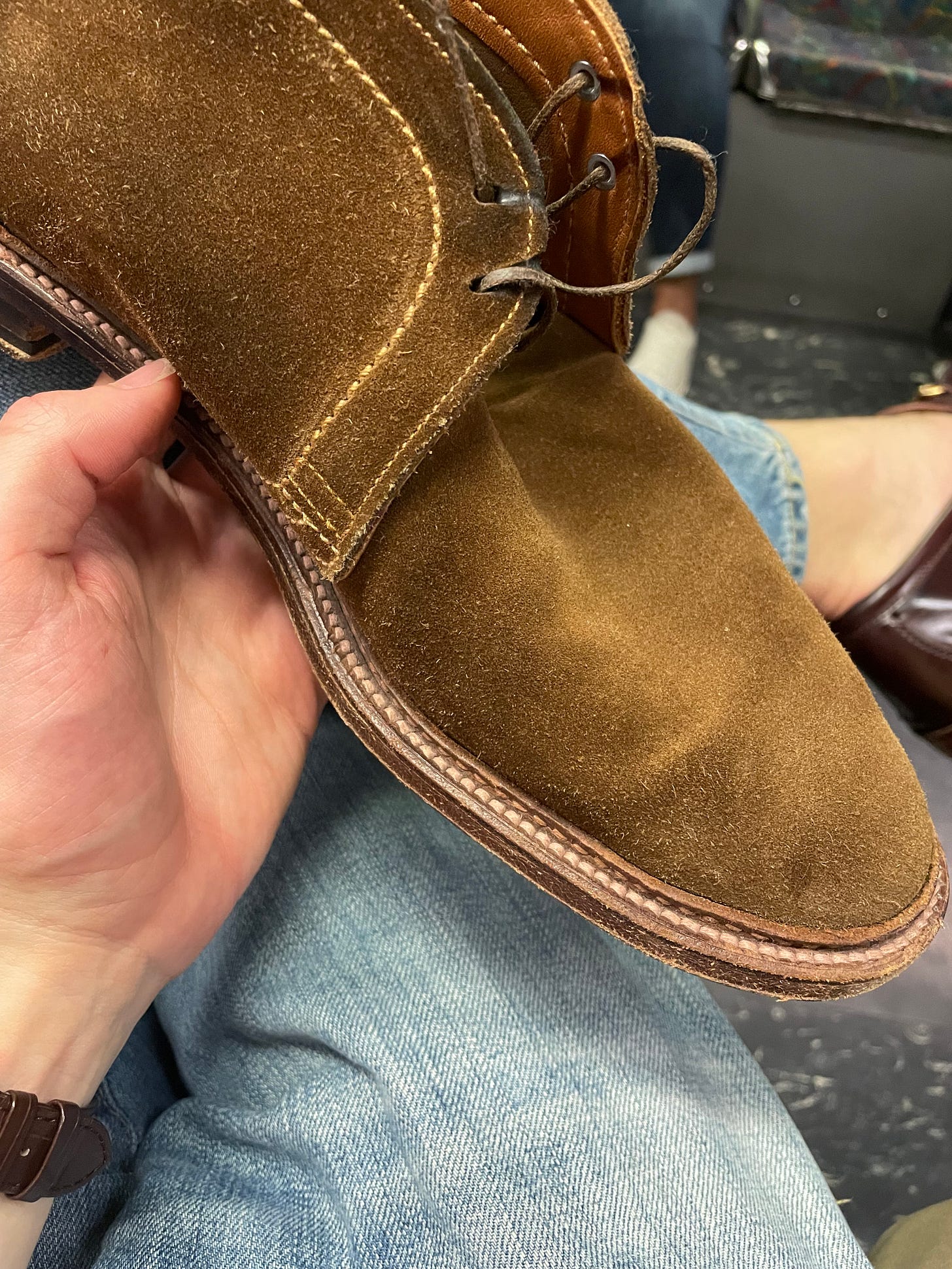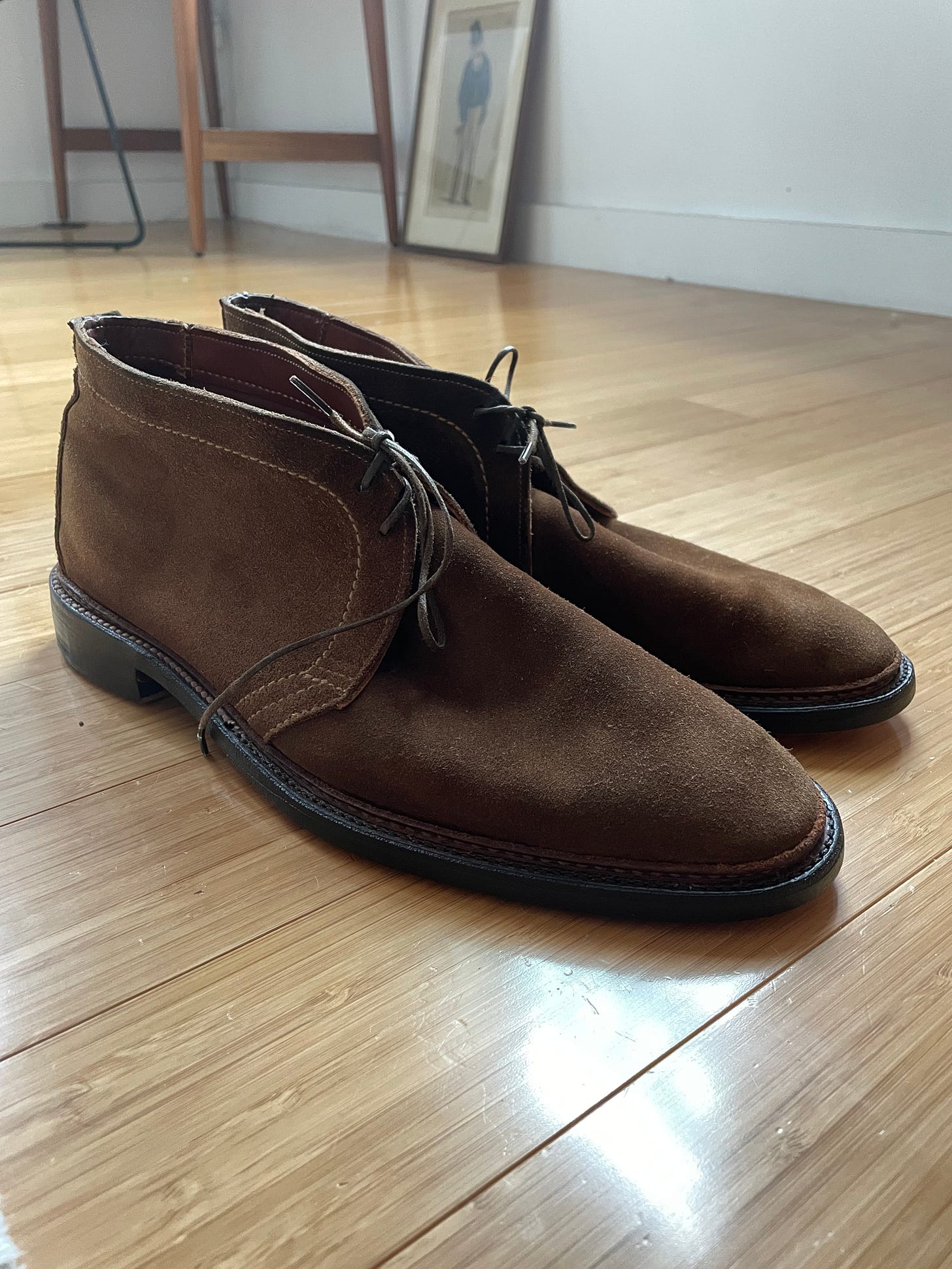The Neverending Quest to Be Less Precious
If you love wearing something, embrace the scuffs, the patina and the change.
Anyone who knows me understands that I can be a bit precious about clothing. To take just one example, I always have at least one Tide-To-Go stick on my person at all times, to combat sudden marinara stains or wine droplets.
This generally, amuses people, and on more than one occasion I’ve provided the stick to an unlucky friend or stranger. But there’s a fine line between being borderline eccentric about the state and quality of your clothing—i.e., having a shoe polish routine and firm opinions about hangers—and being a neurotic pain in the ass.
I’ve strayed into that latter camp more times than I’d like to admit, and I’ve made it a point of trying to be less concerned about the scuffs and stains, whether they appear on a piece of tailoring or footwear (in my quest to re-program my brain, I wrote about this topic for InsideHook back in 2021, with great input from folks including Dan Quigley, David Coggins and Peter Zottolo).
At its worst, the inability to accept the changing appearance of a garment or shoe overtime leads to the impulse to replace it. I’ve had this irrational urge over the years: to cite one example, my beloved pair of unlined, snuff suede Alden leisure handsewns originally purchased from the Andover Shop in 2020.
In a particularly dumb episode from that long, hot summer, I was carrying a couple of Negronis up a spiral staircase—I’d already had a few—and managed to splash a touch of the red-tinged elixir over the lip of a rocks glass and onto the vegetable-tanned suede upper. After the shoe dried I got to work on the resulting spots with a suede brush and suede eraser, though I detected that a dark shadow of the stain remained.
All that summer, I couldn’t so much as cross the street without looking down at the shoe and despairing over the stain, so much so that my neck had begun to hurt from my attempts to inspect its visibility in every possible light. As you might imagine, my enjoyment at wearing the shoe dropped considerably, to the point that I felt I should just buy another pair of the (then) $592 shoes.
But then, at some juncture, the stains… just vanished? I’m sure that’s not the case, so much so that the tarnishes were extremely minor to start with and at a certain point—with the shoes taking on more patina with regular wear—they became totally obscured.
Fast-forward to the start of this summer, and those same, much worn-shoes had finally sprung a hole in their sole. I took them to my longtime cobbler in Beacon Hill, who’s probably resoled my shoes 20 times over, with great results. Only this time, when I picked up the Aldens a few days later, I discerned that something was off about their appearance.
The edge of the replacement soles had been painted a dark brown by my cobbler, a significantly darker shade than the original, antique brown employed by Alden. This, and the black stitching used by my cobbler in place of white, created a contrast with the snuff suede upper that just didn’t sit right.
I was bothered enough by this that I walked back to my cobbler after a few blocks, and asked if there was any way he could make it lighter. He patiently replied that the dark brown dressing was required to make a uniform appearance of the resoled shoe with its new materials, and the machine he operated had only black string. He told me that with wear the dark brown would lighten—but to come back if it was still a problem.
You might know where this is going. After mentally threatening to buy the shoes over again, chucking three years of hard-won patina and footbed comfort out the window, I just began wearing them . After maybe the fourth time out in the resoled shoes, the dark edge dressing and black stitching wasn’t on my mind at all, and true to the cobbler’s word, had been “lightened” in various spots after scraping against cobblestone and brick (I live in the 19th century).
At the start of this month, I took another favored pair of snuff suede, unlined Aldens out—the 1493 chukka—and similarly noticed a hole in the sole. While I’d found my piece with the pennies, I wondered if I shouldn’t just send the chukkas directly back to Alden via its restoration program, which for $200—more than twice my cobbler’s bill—would resole and restore the shoe with all original materials, including its lightweight flex welt sole.
After reaching out to Alden, they’d let me know they could take it on—and return it in 14-16 weeks. I don’t discount that Alden’s service is worth it for many or that the company does an excellent job. But that’s 98 days, at a minimum, plus transit. Considering the difference in turnaround—my cobbler can do it in three days—and price, I realized that the correct course of action was to just be less precious about it and go local.
“But they weren’t resoled with white thread!” No one will say, as that sort of detail will be practically invisible to anyone—including myself—looking at the shoe at eye level. I’d also been concerned that the soles my cobbler were using wouldn’t be quite so light and comfortable as Alden’s flex welt, but after running a quick test by wearing the chukkas on one foot and my resoled loafers on the other, I realized this made little difference.
So, to the cobbler my chukkas went, and came back with darker sole edges, stitching, and to my surprise, American-made leather soles by some maker called “Howes ‘Oak.” My cobbler told me it was a defunct maker, and he has just a few left that he’s keeping for me.
So now I have a pair of Alden chukkas that haven’t been restored to factory settings, but have some interesting differences in the color of their sole edges and stitching that you won’t find anywhere else, plus deadstock American-made leather soles from a long-gone maker. In my book, that’s pretty cool, and I look forward to the further changes that will come with wear—but hopefully not a spilled Negroni, if I can help it.
Cut, Make and Trim
This nascent newsletter is more a less an exercise in thinking out loud. So welcome to a little something I’ve dubbed Cut, Make and Trim, where I plan to stuff in the stray observations, notes on what I’m reading and enjoying, and roundups of what I’ve recently written at the conclusion of whatever I’ve made the topic-du-jour.
This is from a few weeks back, but I’m giving myself a pass as this newsletter is just getting started. For Esquire.com, I asked Alan Flusser and Jonathan Sigmon “What Happened to Well-Dressed Villains?” , riffing on how we went from Gordon Gekko (yes, I know he isn’t real) to George Santos and SBF.
Alan was a delight to speak to, and our phone conversation was close to 90 minutes. At the time my mother-in-law was staying with us, and at the conclusion of the speakerphone conversation, turned to me and asked “Who was that?”
I’d actually meet Flusser once, in person, about five years ago. I was riding an elevator down from the top floor of the Polo Mansion in New York, and when the doors opened, Alan was standing there. You might consider the Polo Mansion to be his natural spawn point.
Speaking of Polo, I recently wrote a piece for InsideHook on the history of Polo Green for which I spoke to the great Laird Mackintosh, aka @vintageprl.
For the piece I was able to expense a 2/3-full bottle of circa 1978 Polo Green listed on eBay for $100, which is the best expense item I’ve listed on an invoice in some time.
And over at Robb Report, I wrote a story about the sheepskin jacket maker Overland on the occasion of its 50th anniversary, which it marked with a new capsule collection. I visited Overland in Santa Fe back in June, and it’s a very interesting brand: one that’s not quite a household name but has a firm footing in mountain resort towns all over the U.S.A.
I gave an interview to a mysterious online magazine called The Byzantium Review, which kindly gave me space to rant on Ivy style, uniform dressing, 20th century American short story writers and the very launch of this substack.
I really enjoyed Jason Diamond’s story on the new Sid Mashburn store in NYC over at GQ. It’s a great example of how “menswear writing” shouldn’t be limited to granular product descriptions—the miniature character sketches Diamonds bangs out from his own in-store experience are great, and the kind of thing of thing that makes me want to be a better writer.
Also at GQ was Joshua Hunt’s longform story on “The Great Italian Tailoring Crisis,” which is precisely the sort of thoughtful, insightful reporting I’d love to see more of in the #menswear world.


